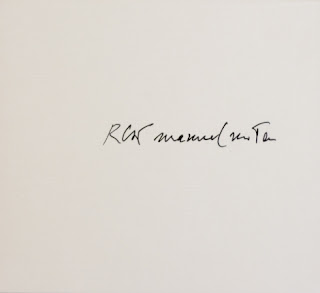
Manuel Mota - rcK (Dromos)
Manuel Mota has always intrigued me, ever since "Leopardo" on Rossbin some ten years ago, but sightings had been few and far between since then. That's been safely remedied with this handsomely produced, five-disc solo set. The recordings are in different circumstances, at home or in concert, and took place between 2009-2012.
Richard covered matters well enough that I'm at pains to add much more. As has been the case in the past, at least with my exposure to his work, Mota uses fairly clear tones in a loosely melodic manner that hints at melodies but never quite states them, instead eddying off to the side with calm, wandering ruminations. For all of the first disc and the first two tracks of the second, the sounds are quite of a piece, pleasantly so, but similar enough to create a strong urge in this listener for, after a while, a change of pace. The third cut on disc II supplies that with a repetition of a single three note figure (two quickly slurred ones and a rising third) that sound like a kind of animal cry before, once again, drifting off into 'Opposite'-era Sugimoto soft ramblings. The live set on Disc III, from Lisbon 2011, benefits from a deeper, fuller room sound, Mota's strongly plucked notes having more air in which to reverberate than in the home recordings, though the music itself continues to reside in that same Mota-space. There's also more of a bluesy, Loren Connors feel here; would have been quite beautiful as a release on its own, my favorite section here. The 2009 Ljubljana set is more abstract, recalling Crimson's "Moonchild" (!) and a bit of Bailey, segueing into some wah wah that ethereally summons 70s Miles. The Instants Chavirés performance is a shade spacier than the prior one, with gentle echoes, velvet soft while the closing piece, home again, returns to the standard mode, albeit with a (relatively) loud section.
There's really very little to criticize--all the music is at the very least enjoyable and, on occasion, very beautiful, if in an elusive manner. Though it's 5 discs, the total time is only around three hours, so it's less to digest than may be immediately apparent. It's satiated by Mota hunger for now. Others who've experienced a pang or two for the same in recent years could do far worse.

Toshimaru Nakamura/Manuel Mota - FoZ (Dromos)
The salient item in this 2011 duet is that Toshi plays guitar throughout, a rare enough event. Short of that, I didn't derive much from the session. The pair of electrics, while sparely played, are harsher than much of the music on the box set though still in Connors territory but absent the deep, forlorn blues. There's something hollow in the sound which might have its own appeal--and sometimes it's almost there for me--but never quite engages. Low groans that fracture abruptly, thick keening offset by Partchian strums. It's an unusually hard go in the sense that it often sounds like I should enjoy it more than I end up doing so. Perhaps it will grow on me over time but for the moment, Mota's solo work, at its best, far outstrips this session.
I love Margarida Garcia's cover design and lettering, though; arguably worth it for that alone!
Dromos




